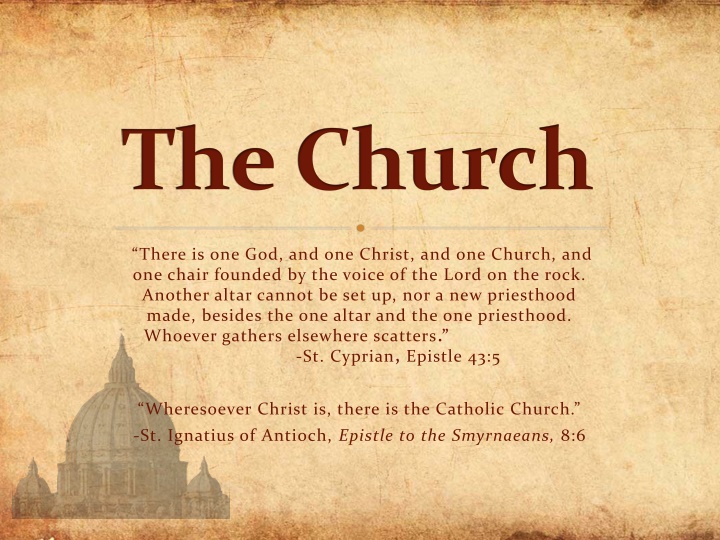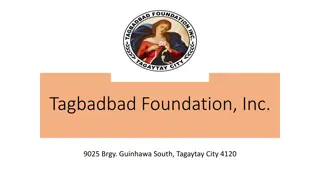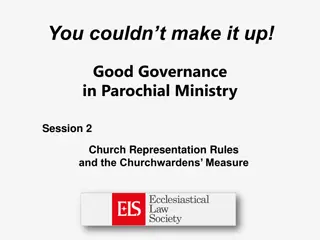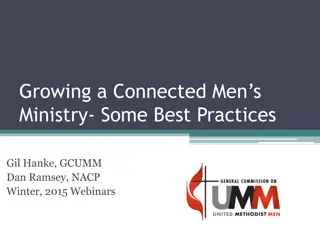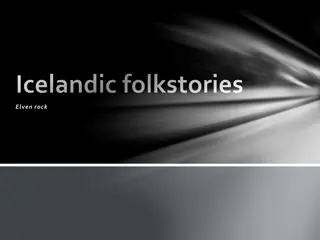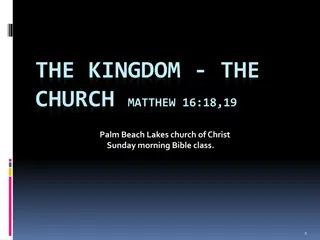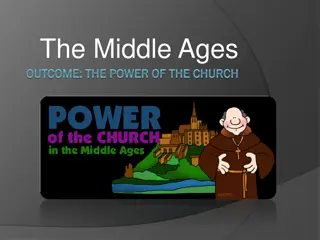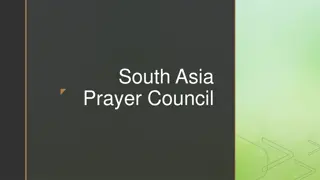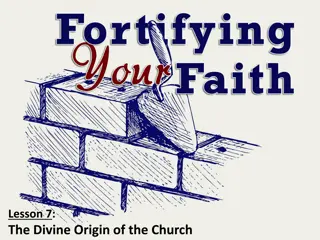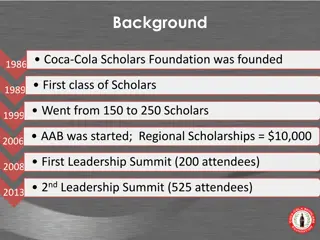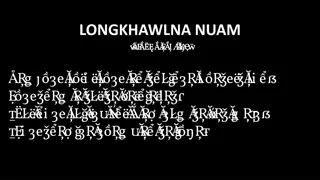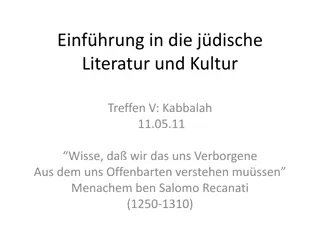The Church: Foundation, Etymology, and Mystical Body
The Church, founded by Christ, holds a rich history from the Old Testament to the present day. Its establishment, meaning, and unity as the Mystical Body of Christ are explored through key figures and teachings. The word "Church" carries historical significance, tracing back to its Greek and Latin roots, emphasizing the assembly of believers under one faith. Understanding the Church's role as the vessel for grace and unity with Christ sheds light on its importance in Christian doctrine.
Download Presentation

Please find below an Image/Link to download the presentation.
The content on the website is provided AS IS for your information and personal use only. It may not be sold, licensed, or shared on other websites without obtaining consent from the author.If you encounter any issues during the download, it is possible that the publisher has removed the file from their server.
You are allowed to download the files provided on this website for personal or commercial use, subject to the condition that they are used lawfully. All files are the property of their respective owners.
The content on the website is provided AS IS for your information and personal use only. It may not be sold, licensed, or shared on other websites without obtaining consent from the author.
E N D
Presentation Transcript
The Church There is one God, and one Christ, and one Church, and one chair founded by the voice of the Lord on the rock. Another altar cannot be set up, nor a new priesthood made, besides the one altar and the one priesthood. Whoever gathers elsewhere scatters. -St. Cyprian, Epistle 43:5 Wheresoever Christ is, there is the Catholic Church. -St. Ignatius of Antioch, Epistle to the Smyrnaeans, 8:6
Etymology of the Word Church The English word Church is a corruption of the Greek word kyriakon , meaning the Lord s house, from kyrios (lord). French, Spanish, Italian and all of the Romance languages use variations of the Latin word for Church, ecclesia, itself a derivation of the Greek ekklesia, which in its pre-Christian context meant an assembly
In the Old Testament Since Old Testament times, God always had a people or society on the earth whereby His decrees were made manifest and His will acted out on the earth In the Old Testament prophecies, the establishment of the New Covenant, the gathering together of the nations into one assembly (ecclesia), and the offering of a pure sacrifice are all bound up intimately with the coming of the Messiah, the priest par excellence
The Church-Established by Christ When Christ came to earth, He instituted His Holy Church as the means by which all men would come to the knowledge of God and, through which, the grace of Christ merited by His death on the cross would be diffused through the means of the sacraments. This Church of Christ is built upon the foundation of the apostles (Rev. 21:14) with Peter as its earthly head. Christ gave governance of the Church to Peter (Matt.16:13-19) and to his successor who, in collegiality with the bishops as successors of the apostles, are to govern the visible Church until the Second Coming.
The Mystical Body The phrase Mystical Body of Christ is meant to describe the unity of Christ with His Church. Christ is not simply the hierarchical head of the Church, the way a CEO is head of a corporation; Christ both rules the Church and is immediately present in her through the sacramental ministry of the priesthood, the guidance of the whole Church by the Holy Spirit the reception of the sacramental Body of Christ by the faithful at the Mass As St. Paul teaches, Christ loved the Church and gave Himself up for her, that He might sanctify her (Eph. 5:25). Christ is so identifiable with is Church that it is Christ together with His Church that is said to make up the Totus Christus, the whole Christ.
One flesh Christ is not the Head of the Church the way that, for example, the President is the head of the executive branch of government or that Bill Gates is the head of Microsoft; rather, He is the Head in the way that the husband is head of the wife, and the both of them together in unity are one flesh. St. Paul makes this clear when he teaches that the husband is the head of the wife as Christ is the head of the Church, his body, and is himself its Savior
Scripture Verses Attesting to the Oneness of Christ with His Church Now as he journeyed he approached Damascus, and suddenly a light from heaven flashed about him. And he fell to the ground and heard a voice saying to him, Saul, Saul, why do you persecute me? And he said, Who are you, Lord? And he said, I am Jesus, whom you are persecuting (Acts 9:3-5). There is neither Jew nor Greek, there is neither slave nor free, there is neither male nor female; for you are all one in Christ Jesus (Galatians 3:28). I am the vine, you are the branches. He who abides in me, and I in him, he it is that bears much fruit, for apart from me you can do nothing (John 15:5). Now you are the body of Christ and individually members of it (I Corinthians 12:27). That they may all be one; even as thou, Father, art in me, and I in thee, that they also may be in us, so that the world may believe that thou hast sent me (John 17:21).
Visible & Invisible The Church is both the mystical Body of Christ and a hierarchical society, both a visible organization and a spiritual community, both an earthly Church and a Church endowed with heavenly riches. These aspects of the Church are one complex reality which comes together from a human and a divine element (CCC 771). Pope Leo XIII taught that When one visualizes the ultimate purpose of the Church and the proximate causes effecting sanctity, she is, in fact, spiritual. But when one considers the members of the Church and the means which lead to the spiritual gifts, the she is externally and necessarily visible (Leo XIII, Satis Cognitum, 1896)
Visible & Invisible The invisible aspect of the Church is comprised of all of the saints and angels in heaven (the Church Triumphant) all of the members suffering in Purgatory (the Church Suffering) all of the elect here on earth working out their salvation (the Church Militant) The visible Church, on the other hand, constitutes those who are incorporated into her by baptism and are in communion with the visible head of the Church on earth, the Bishop of Rome. The sign of visible unity of the local church is the Bishop; local churches preserve their unity by communion with the head of the universal Church, the Bishop of Rome.
The Four Marks of the Church One, Holy, Catholic and Apostolic
The Church Is One The unity of the Church is a supernatural unity possessed by virtue of Christ s unity with the Father (see John 17:21). The unity is both a unity of supernatural charity and of doctrine. The Church is One because she believes the one doctrine handed on to her by the Apostles St. Paul said: There is one body and one Spirit, just as you were called to the one hope of your calling, one Lord, one faith, one baptism, one God and Father of us all, who is above all and through all and in all (Eph. 4:4-6) St. Cyprian said: "There is one God, and Christ in one, and there is one church, and one episcopate he can no longer have God for his Father who has not The Church for his mother (Unity of the Catholic Church, 6).
The Church Is Holy The Church is called holy not because every one of her members individually is holy, but because Christ, who is unfailingly holy, has united Himself to Her and in her resides the fullness of grace and all of the means of salvation given to man. 823 The Church . . . is held, as a matter of faith, to be unfailingly holy. This is because Christ, the Son of God, who with the Father and the Spirit is hailed as alone holy, loved the Church as his Bride, giving himself up for her so as to sanctify her; he joined her to himself as his body and endowed her with the gift of the Holy Spirit for the glory of God. 825 The Church on earth is endowed already with a sanctity that is real though imperfect. In her members perfect holiness is something yet to be acquired: ...are called by the Lord to that perfection of sanctity by which the Father himself is perfect.
The Church Is Catholic The word catholic means universal. The Church is catholic in a double sense: First, the Church is catholic because Christ is present in her Secondly, the Church is catholic because she has been given a mission to all mankind. In addition to this, each local church is catholic. Local churches are catholic by virtue of their organization around a bishop their participation in sacramental life administered by a valid priesthood their communion with the Church of Rome.
The Church Is Apostolic The Church was founded by the Apostles by the mandate of Christ; It faithfully hands on the teaching of the Apostles without error In the person of the bishops, the successors of the Apostles, the Church continues to be guided by them.
Relationship with Israel The rituals of the Old Testament were never salvific for the Jews, even in Old Testament times (Heb. 10:4). The rituals were given for signs to prefigure the coming of the Messiah who, with the New Covenant, would inaugurate a new economy of signs (sacraments) that were actually able to effect what the symbolized. The law was our custodian until Christ came (Gal. 3:24). Jews who were saved under the Old Covenant, though God used the rituals of the law to save them, were not saved because of the rituals but because of the anticipated merits of Christ s crucifixion, which were applied to the rituals carried out in faith. The New Covenant was not to abolish the Old, but to interiorize it and make the promises (and moral mandates) of the Old Covenant attainable (Jer. 31:31-34).
Relationship with Israel Christ taught that He came to fulfill the Old Law, not to abolish it (Matt. 5:17). In inaugurating the New Covenant, Christ extends it beyond Judaism to all peoples, who are now able to be grafted into God s family. Thus, the Gentiles are now part of Israel (Rom. 11:11-24). With the fulfilling of the Old Covenant, the merely preparatory rituals of the Old Covenant are no longer needed: In speaking of the new covenant he treats the first as obsolete. And what is becoming obsolete and growing old is ready to vanish away (Heb. 8:13). The New Testament Church, made up of all nations, is the Israel of God (Gal. 6:16). Not in the sense that they are a new Israel, but in that they are the fulfillment and unfolding of everything the old Israel was ever meant to be.
In StatuViae(In a state of journeying ) Until the coming of Christ, the Church continues on in a state of journeying, afflicted in every way but not crushed; perplexed, but not driven to despair; persecuted but not forsaken; struck down but not destroyed (2 Cor. 4:8-9) At the Second Coming, when Christ gathers His people to Himself, every obstacle between complete union between God and His Church will be removed, so that God may be all in all (1 Cor. 15:28) and the Church will reign with Christ throughout eternity. This union of Christ and the Church is mystically participated in every time we attend Mass, where the Spirit and the Bride say, Come (Rev. 22:17).
Lesson content courtesy of http://www.unamsanctamcatholicam.com Power Points prepared by Catholic Presentations
